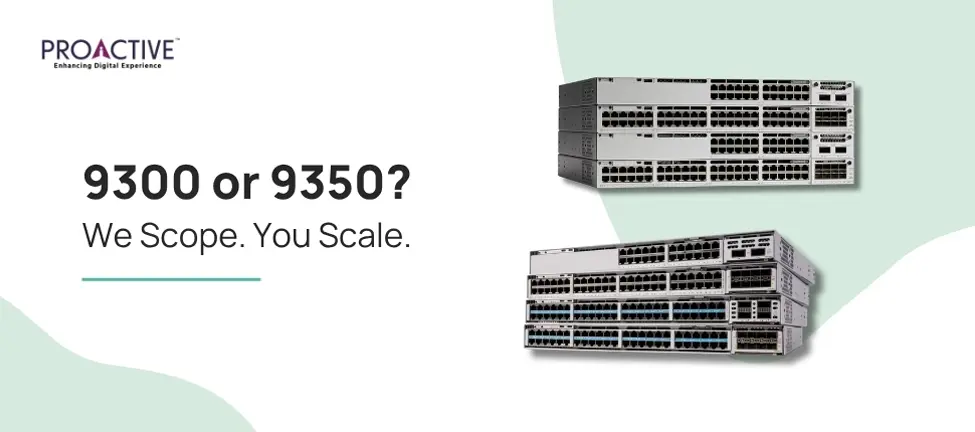Updated: July 30, 2025

One of India’s top insurance providers deployed Catalyst 9300s across 11 floors. Six months later, their wireless APs started rebooting mid-shift. The problem wasn’t the Wi-Fi. It was PoE under-sizing. They had picked the wrong SKU.
Cisco's Catalyst 9300 and 9350 are built for different outcomes. But in many procurement processes, that distinction is lost. Specs are compared in isolation, without matching network design, application loads, and policy requirements.
This guide is for teams who don’t want to course-correct six months into deployment.
Catalyst 9300 supports access switching at scale. It delivers modular uplinks, StackWise-480 support, full PoE+ across ports, and SD-Access readiness. For most enterprise access closets, it is more than sufficient.
If your topology includes:
Then 9300 will meet the brief. But if your deployment involves distributed enforcement, local telemetry, or AI workloads, 9300 hits a ceiling.
The 9350 wasn’t built for port parity. It was built for performance predictability.
It comes with higher base memory, faster CPU, NVMe storage, and support for hardware-level security policies. It enables containerized app hosting, MACsec-256, and TrustSec enforcement at line rate.
In procurement terms, it moves inspection and enforcement closer to the edge. For workloads involving AI, video analytics, or zero-trust enforcement, this makes it non-negotiable.
1. Power Budget vs Device Growth
Don’t assume your current PoE needs will stay fixed. If you're adding Wi-Fi 6E, AI cameras, or USB-C powered edge devices, you need 90W PoE ports. 9350 supports higher power densities.
2. Uplink Modularity
If you’re connecting to distribution switches over fiber, or planning for 25G/100G links, modular uplinks in 9350X or 9300X are essential. Fixed uplinks limit your growth window.
3. App Hosting and Telemetry
CIOs increasingly demand edge visibility. The 9350 lets you run local AI probes or analytics agents. 9300 doesn’t.
4. License Alignment
Both platforms run on DNA licenses. But if you’re investing in DNA Advantage for segmentation, telemetry, and policy orchestration, the 9350 lets you extract more value.
5. Policy Consistency
If you're already running TrustSec or SD-Access at your WAN or DC edge, the 9350 allows identity enforcement at the access layer. That’s key for zero-trust frameworks.
6. Lifecycle Costs
A cheaper SKU may save on day-zero CAPEX. But when incident volumes rise due to misalignment, the OPEX impact outweighs the savings. Proactive has measured this gap in multiple client rollouts.
We’ve seen teams over-order PoE where it’s not needed, then fall short where power-hungry devices surge. Others choose 9300s for SD-Access environments, only to retrofit features post-deployment at 2x cost. The biggest red flag is treating 9300 and 9350 as interchangeable for pricing reasons.
One manufacturing firm in Gujarat chose 9300s across their sites without checking fiber uplink support. When they expanded inter-floor links from 1G to 10G, their switches bottlenecked. Every replacement required re-patching and nighttime change windows. The delay set their plant readiness back by two fiscal quarters.
3-Year Cost Comparison (Sample 24-port deployments with comparable DNA Advantage licensing):
This doesn’t even include soft costs like project delays or audit compliance failures.
Most partners treat SKU selection as a back-office function. Proactive treats it as design.
We map power grid constraints. We model device expansion timelines. We benchmark failover response against target SLAs. Then we align the switch SKU, license tier, and configuration blueprint.
Procurement doesn’t have to play system integrator. That’s our job.
Catalyst 9300 and 9350 serve different purposes. Choosing the wrong one may not break your network on day one, but it will break your operations down the line.
Get the switch right the first time. Get the rollout done with Proactive.